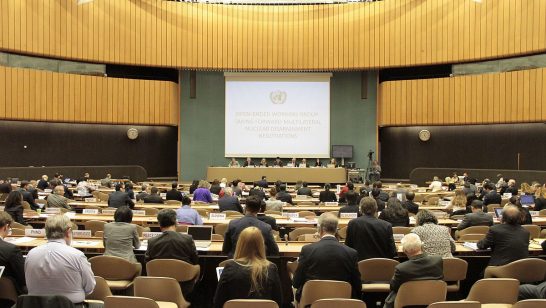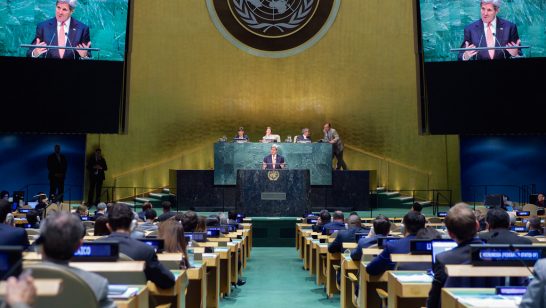
The future is yet to be written for the Korean Peninsula, but without the successful negotiation and implementation of tangible assurances and strong verification of disarmament pledges, a new era cannot peacefully unfold. By learning from its mistakes and setting realistic expectations, the international community can leverage this diplomatic opening to negotiate better security for not only the Korean Peninsula but also the entire world. As the processes of normalization and negotiation have both proven to be easier said than done, the Greater European community should suggest opportunities for confidence building along the way.
Recent events at North Korea’s Punggye-ri nuclear test site prove that the international community is not utilizing the full extent of the diplomatic and scientific tools at its disposal. After the North and South formally announced a declaration of peace, it was reported that Kim Jong Un was open to allowing international journalist and expert observers to Punggye-ri to verify its closure or dismantlement. Considered a vital contribution towards efforts to rid the peninsula of nuclear weapons, this step was rightfully welcomed by the international community. Unfortunately, the eventual news that only journalists would be allowed to the test site was highly disappointing. Since then, however, what has perhaps been even more disappointing is the fact that the international community has not adequately contested the overreaching political capital, and therefore diplomatic advantages, gained by North Korea’s maneuvering of the situation.
Current discourse surrounding the test site highlights the immense need for independent technical expertise to be a part of the discussion. Above all else, one must remember that conducting controlled demolitions of certain tunnel entrances to a nuclear test site is not the same as (1) transparently, verifiably decommissioning the entire test site and (2) making a nuclear testing moratorium permanent by committing to international law. For these reasons, the international community must immediately begin a campaign of support to raise the profile of the Comprehensive Nuclear-Test-Ban Treaty (CTBT).
Simply put, the CTBT was written to close the door to global nuclear testing once and for all by banning all nuclear explosions. Global leaders spent three years negotiating the text before coming to a consensus in 1996 as the grave consequences of nuclear testing became increasingly apparent. Unfortunately, the CTBT continues to exist in limbo over twenty years since then because it cannot enter into force until it is ratified by the remaining eight nuclear technology holding countries listed in Annex 2 of the treaty: China, Egypt, North Korea, India, Iran, Israel, Pakistan, and the United States.
In some ways, the CTBT is a victim of its own success. Over the past two decades, a billion-dollar verification regime has been built to monitor the world for potential nuclear explosions. Nearly 90 percent of the 337 facilities of the International Monitoring System (IMS) are already in place and transmit data to a team of highly trained experts who scrutinize it in real-time. For example, the system swiftly detected and gave crucially unique information on all six of North Korea’s declared nuclear tests. Despite the agility and accuracy of the IMS to reinforce the well-established norm against nuclear testing, more Annex 2 country ratifications have not occurred since Indonesia in 2011.
Given the multipolar, complex deterrence structures the world now frantically operates within, relegating the CTBT to the back burner is unacceptable. To demonstrate sincerity and build confidence amongst relevant parties, the United States, China, and North Korea should all include the prospects of ratifying the CTBT early on during upcoming talks. The US and China both have no technical need to test nuclear weapons anymore, yet the CTBT ironically remains in a logjam because their ratifications remain incomplete. For example, despite being the first to sign the treaty and currently paying nearly a quarter of the treaty organization’s annual budget, the US has not even been able to hold hearings on the treaty’s potential ratification since 1999.
At present, the Trump administration and Republican-led US Senate continue the American trend of not productively discussing the CTBT. For example, at recent Nuclear Non-Proliferation Treaty (NPT) Preparatory Committee meetings in Geneva, the American delegation echoed what was written in the recent US Nuclear Posture Review (NPR): the United States will not pursue ratification of the CTBT but will continue to offer its financial support and abide by its own moratorium. This statement has been a cause of concern for many of the 166 CTBT-ratifying states, especially as it has been matched by shifts in American policy that have quietly made it easier for the United States to re-engage in nuclear testing if desired. A review of all American nuclear commitments, including the CTBT, that is not mutually dependent on the NPR is currently underway. The conclusion of this review is an opportunity to showcase that the United States is willing to submit itself to the same level of scrutiny it wants the rest of the world subjected to. However, it is likely that the result of this review will be yet another example of American shortsightedness when it comes to the CTBT.
Given these circumstances, it would be in North Korea’s strategic interest to explicitly begin raising the CTBT to highlight potential double standards that may emerge from other negotiating parties that have not followed through on their own nonproliferation and disarmament commitments. In addition to resolving its relationship with the NPT by fully implementing safeguards and returning to the treaty as a non-nuclear weapons state, North Korea’s immediate accession to the CTBT – as an accredited observer state, signatory, or ratifying state – is of equal importance. Luckily, North Korea has already expressed interest in joining international efforts towards a global ban of nuclear testing.
Large-scale European support for the CTBT offers a glimmer of hope that necessary capacity building can occur amongst the next-generation of global leaders to properly appreciate the merits of the treaty. Bringing its voluntary contributions up to a total of 23.5 million Euros this year, the EU is continuing its outstanding support to the Comprehensive Nuclear-Test-Ban Treaty Organization (CTBTO) annual budget — a budget that EU member states collectively already pay 40% of in order to strengthen both scientific and diplomatic efforts to secure the treaty. Given its various linkages to the CTBTO, the EU should be at the forefront of urging the CTBT to be introduced early on during talks with North Korea. For example, the EU could offer to help train North Korean technical experts in exchange for North Korea allowing (1) the installation of CTBTO noble gas and spectral imaging equipment to monitor Punggye-ri and (2) at a minimum becoming a signatory to the CTBT to reach parity with the US and China. Although allowing the installation of an IMS facility would be welcomed, it is not necessary due to the scope and reach of the system’s current ability to detect North Korean tests and may constitute as too intrusive of a measure at this point in time.
In the words of Joshua Pollack, the lack of explicit mentions of the CTBT “resounds loudly” and must be discussed. Making the environment more encouraging for North Korea to feel comfortable with having a relationship with international organizations such as the CTBTO and International Atomic Energy Agency (IAEA) is key to this summer’s “denuclearization” agenda. To improve upon current strategies, the EU should employ a proactive, integrated diplomatic strategy alongside Russia — an ardent supporter of the CTBT and arguably the closest diplomatic partner to North Korea — to ensure it has the profile it deserves in the coming months. It was telling that on the same exact day this past month, the CTBT was being raised in Paris, Brussels, and Vienna by the highest levels of EU and Russian Foreign Ministries. In order to make the test-ban treaty legally binding, a converged, multilateral approach must be deployed, and rallying around the CTBT may offer a space for cooperation between the EU and Russia that seems hard to come by these days. After all, the necessity of the CTBT’s entry-into-force is one of few things that all Greater European countries are strongly in agreement over.
The opinions articulated above also do not necessarily reflect the position of the European Leadership Network or any of its members. The ELN’s aim is to encourage debates that will help develop Europe’s capacity to address pressing foreign, defence, and security challenges.
Resources:
To learn more about the Punggye-ri nuclear test site, interact with the 3-D model produced by the James Martin Center for Nonproliferation Studies (CNS) at the Middlebury Institute of International Studies, supported by the Nuclear Threat Initiative (NTI).
To learn more about the differing roles of the CTBTO and IAEA in the process of “denuclearizing” the Korean Peninsula, read Tariq Rauf’s article “Shutting down Punggye Ri” for the Atomic Reporters.



